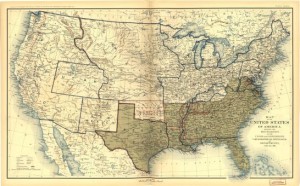 Minor skirmishes continue to mark the month of April, such as today’s Battle of Salyersville. The Kentucky town, like many in that state and in Magoffin County in particular, is by now used to the tug-of-war between Union and Confederate forces. The town’s citizenry is comprised, to a significant degree, of former Virginians. Not particularly prosperous, Salyersville claims few slaveholders. Many residents support the United States, while some sympathize with the Confederate States.
Minor skirmishes continue to mark the month of April, such as today’s Battle of Salyersville. The Kentucky town, like many in that state and in Magoffin County in particular, is by now used to the tug-of-war between Union and Confederate forces. The town’s citizenry is comprised, to a significant degree, of former Virginians. Not particularly prosperous, Salyersville claims few slaveholders. Many residents support the United States, while some sympathize with the Confederate States.
Confederate Colonel Ezekiel F. Clay is one of several officers who are known for leading rebel raids in Union-controlled areas of Kentucky. Today Clay’s mounted infantry attack the Union position at Paintsville in eastern Kentucky, commanded by Union Colonel George W. Gallup. The federals hold their position, and, when fighting resumes on the morrow, push the Confederates to Salyserville. The rebels incur heavy losses, including the capture of Colonel Clay, some 100 horses and a large quantity of arms.
The skirmish is of no real significance in the bigger picture, although the fate of the Confederacy so hangs in the balance that any loss by this point is a bitter pill to swallow for the Confederacy.
Meanwhile, near the far western perimeter of the war, yet another Baptist church becomes a casualty of the three-year-old war, as reported by Texas’ Galveston Weekly News:
Shreveport, April 13th, 1864.
. . . A distressing affair occurred on Sunday night about 2 o’clock. The large Baptist Church in Mansfield, used for a hospital, caught fire by accident, and in a short time was totally consumed, together with one of the gallant wounded. The fire occurred in the following manner: A nurse in the hospital let a lighted candle fall on the cotton scattered over the floor, which immediately caught and spread over the building almost as quick as a flash of gunpowder. The whole building was almost instantly enveloped in flames, and the wounded were secured with the utmost difficulty. Some poor fellows, no doubt, in being dragged out, suffered intense agony, but I did not hear a groan from but a single man, and he had been dragged at least 100 yards.
Many of the prisoners that I saw were raw Germans and Irish, some of them but a few months from the “old country.” Many of them were zouaves, with flowing red pants, that looked, at a distance like a short petticoat. One of the German regiments was captured en masse. Our men were about to fire upon them, when one of the leaders cried out in the “sweet silvery accents” of his native land: “Shentleman, don’t shoot we does give right up.” . . .
Sources: Salyersville, Kentucky (link); Battle of Salyersville (link); Galveston Weekly News, April 20, 1864 (link)


